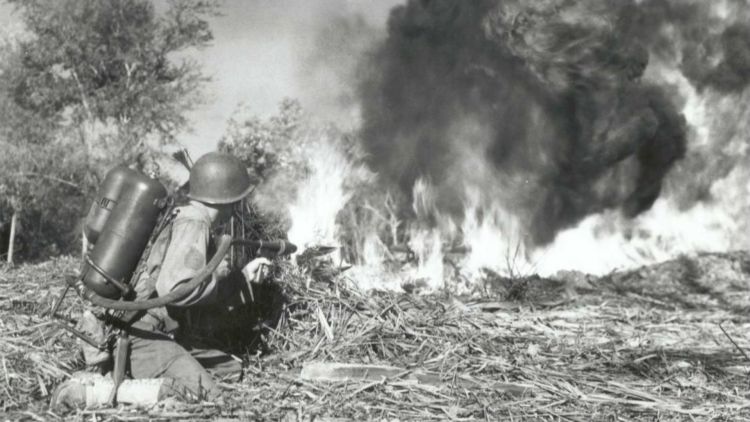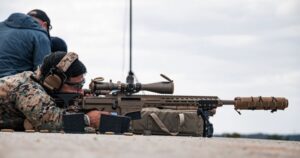Fire has long been a weapon of terror and destruction, dating back to the 7th century AD when the Greeks developed the infamous Greek fire. This potent incendiary weapon was both a psychological and physical force on ancient battlefields.
Fast-forward to World War I and the flamethrower emerged as a battlefield game-changer, with the Germans leading the charge in its widespread use.
By World War II, nearly every military force wielded some version of this fearsome device, marking the flamethrower as an iconic and deadly tool of war.
The Mechanics of Military Flamethrowers
Military flamethrowers relied on liquid fuels, such as gasoline or napalm, to project flames over distances of 50 to 100 meters. These were not mere torches like Elon Musk’s cheekily named “Not-a-Flamethrower,” which uses propane gas and is better classified as a novelty torch.

Military flamethrowers delivered sustained jets of fire capable of overwhelming entrenched positions.
During World War II, flamethrowers were deployed in various forms: strapped to infantrymen’s backs, mounted on vehicles, or integrated into tanks. Their effectiveness was unparalleled in clearing bunkers and fortifications, particularly in the Pacific theater.
Against Japanese defenders entrenched in caves and pillboxes, flamethrowers allowed Allied forces to incinerate enemy positions without exposing themselves to extreme risk.
The Heavy Burden of the Flamethrower Man
For the soldier carrying the flamethrower, the experience was both empowering and perilous.
Fire has long been a weapon of terror and destruction, dating back to the 7th century AD when the Greeks developed the infamous Greek fire. This potent incendiary weapon was both a psychological and physical force on ancient battlefields.
Fast-forward to World War I and the flamethrower emerged as a battlefield game-changer, with the Germans leading the charge in its widespread use.
By World War II, nearly every military force wielded some version of this fearsome device, marking the flamethrower as an iconic and deadly tool of war.
The Mechanics of Military Flamethrowers
Military flamethrowers relied on liquid fuels, such as gasoline or napalm, to project flames over distances of 50 to 100 meters. These were not mere torches like Elon Musk’s cheekily named “Not-a-Flamethrower,” which uses propane gas and is better classified as a novelty torch.

Military flamethrowers delivered sustained jets of fire capable of overwhelming entrenched positions.
During World War II, flamethrowers were deployed in various forms: strapped to infantrymen’s backs, mounted on vehicles, or integrated into tanks. Their effectiveness was unparalleled in clearing bunkers and fortifications, particularly in the Pacific theater.
Against Japanese defenders entrenched in caves and pillboxes, flamethrowers allowed Allied forces to incinerate enemy positions without exposing themselves to extreme risk.
The Heavy Burden of the Flamethrower Man
For the soldier carrying the flamethrower, the experience was both empowering and perilous.
Strapped with a tank of volatile fuel and a weapon capable of unleashing hellfire, the “flamethrower man” was a walking target. Snipers often prioritized these soldiers, knowing the devastation they could unleash.
However, Hollywood myths about exploding tanks of fuel rarely held true. The liquid fuel used in military flamethrowers was resistant to ignition by stray bullets.

When tanks did explode, it was usually due to grenades or artillery hits that would have been lethal regardless of the weapon.
Using a flamethrower also came with physical and tactical challenges.
The equipment was cumbersome, requiring the operator to conserve their limited fuel. The short range of the weapon meant operators had to get dangerously close to enemy positions.
Worse, the risk of burns—whether from enemy fire or mishandling the weapon—was ever-present.
The Many Ways Flamethrowers Killed
Flamethrowers didn’t just kill through immolation, though that was their most dramatic effect.
The intense heat they generate could kill indirectly through hyperthermia, overwhelming the body’s ability to regulate temperature.
In confined spaces, the fire consumed oxygen and produced toxic gases like carbon monoxide, causing asphyxiation.
Victims might appear unburned, leading to a misconception that flamethrowers were a “humane” weapon.
This belief gained traction during World War II when Lt. Col. Orbe Bostick wrote a report claiming flamethrowers were “mercy killers.”

However, firsthand accounts from soldiers told a different story.
Victims of flamethrower attacks often died slow, agonizing deaths, with their screams echoing across battlefields.
While the colonel’s report might have offered post-war comfort to some veterans, it didn’t reflect the grim reality faced by those on the ground.
Flamethrowers After the Wars
Flamethrowers fell out of favor as a weapon of war in the 1980s, largely banned under international conventions due to their inhumane nature.
The United States military still uses flamethrowers, but only as tools for clearing brush or destroying enemy cover—not as weapons. Their role has shifted from combat to utility, a stark contrast to their fearsome battlefield legacy.
The Flamethrower’s Modern Revival: Drones in 2024
While handheld flamethrowers have been relegated to history books and niche civilian markets, fire as a weapon has found a new life in modern warfare.
In 2024, flamethrower drones have emerged as a controversial yet effective tool in asymmetric warfare. Armed with precision fire-launching systems, these drones can incinerate enemy supply depots, detonate explosives from a safe distance, or clear dense vegetation hiding enemy forces.
The resurgence of flame weapons via drones reflects a chilling evolution: the ability to project terror and destruction remotely without putting operators at risk.
As military technology advances, the legacy of the flamethrower lives on—not as a relic of the past but as a tool reimagined for the modern battlefield.
This article originally appeared on SOFREP in November 2021, written by Travis Pike. It has since been revised and updated by the SOFREP News Team to provide the latest insights and information.



